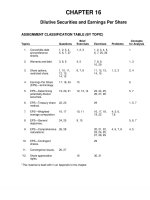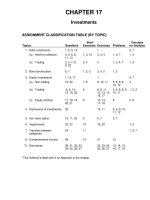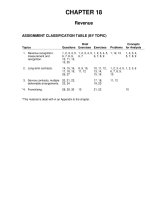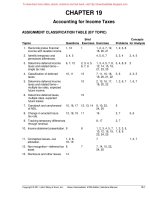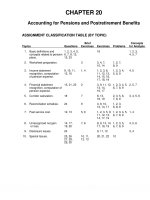Intermediate accounting IFRS 3rd ch12
Bạn đang xem bản rút gọn của tài liệu. Xem và tải ngay bản đầy đủ của tài liệu tại đây (1.67 MB, 56 trang )
Prepared by
Coby Harmon
University of California, Santa Barbara
Westmont College
12-1
Intangible Assets
CHAPTER 12
LEARNING OBJECTIVES
After studying this chapter, you should be able to:
1. Discuss the characteristics,
valuation, and amortization of
intangible assets.
2. Describe the accounting for
various types of intangible
assets.
3. Explain the accounting issues for
recording goodwill.
12-2
4. Identify impairment
procedures and presentation
requirements for intangible
assets.
5. Describe the accounting and
presentation for research and
development and similar
costs.
PREVIEW OF CHAPTER 12
12-3
Intermediate Accounting
IFRS 3rd Edition
Kieso ● Weygandt ● Warfield
Intangible Asset Issues
Characteristics
Identifiable.
Lack physical existence.
LEARNING OBJECTIVE 1
Discuss the characteristics,
valuation, and amortization of
intangible assets.
Not monetary assets.
Normally classified as non-current asset.
Common types of intangibles:
12-4
Christian Dior’s
(FRA) most
important asset is its
brand image, not its
store fixtures.
1. Marketing-related.
4. Contract-related.
2. Customer-related.
5. Technology-related.
3. Artistic-related.
6. Goodwill.
LO 1
Intangible Asset Issues
Valuation
Purchased Intangibles
12-5
Recorded at cost.
Includes all acquisition costs plus expenditures to make
the intangible asset ready for its intended use.
Typical costs include:
►
Purchase price.
►
Legal fees.
►
Other incidental expenses.
LO 1
Valuation
Internally Created Intangibles
12-6
Might include patents, computer software, copyrights,
and trademarks.
Companies expense all research phase costs and some
development phase costs.
Certain development costs are capitalized once
economic viability criteria are met.
IFRS identifies several specific criteria that must be met
before development costs are capitalized.
LO 1
Intangible Asset Issues
Internally Created Intangibles
ILLUSTRATION 12.1
Research and Development Stages
12-7
LO 1
Intangible Asset Issues
Amortization of Intangibles
Limited-Life Intangibles
12-8
Amortize by systematic charge to expense over useful life.
Amortization expense should reflect the pattern in which
the company consumes or uses up the asset.
Credit asset account or accumulated amortization.
Amortization should be cost less residual value.
Companies must evaluate the limited-life intangibles
annually for impairment.
LO 1
Intangible Asset Issues
Amortization of Intangibles
Indefinite-Life Intangibles
12-9
No foreseeable limit on time the asset is expected to
provide cash flows.
No amortization.
Must test indefinite-life intangibles for impairment at least
annually.
LO 1
Intangible Asset Issues
Amortization of Intangibles
ILLUSTRATION 12.2
Accounting Treatment for Intangibles
12-10
LO 1
LEARNING OBJECTIVE 2
Describe the accounting for
various types of intangible
assets.
Types of Intangible
Assets
Six Major Categories:
12-11
1.
Marketing-related.
4.
Contract-related.
2.
Customer-related.
5.
Technology-related.
3.
Artistic-related.
6.
Goodwill.
LO 2
Types of Intangible Assets
Marketing-Related Intangible Assets
Examples:
►
12-12
Trademarks or trade names, newspaper
mastheads, Internet domain names, and noncompetition agreements.
Under common law, the right to use a trademark or
trade name rests exclusively with the original user
as long as the original user continues to use it.
Capitalize purchase price.
No amortization.
LO 2
What Do The Numbers Mean?
Keep Your Hands Off My
Intangible!
Companies go to great extremes to protect
their valuable intangible assets. Consider
how the creators of the highly successful
game Trivial Pursuit protected their creation.
First, they copyrighted the 6,000 questions
that are at the heart of the game. Then, they
shielded the Trivial Pursuit name by
applying for a registered trademark. As a
third mode of protection, they obtained a
design patent on the playing board’s design
as a unique graphic creation.
Another more recent example is the
case of Converse (owned by Nike (USA))
and its eff orts to protect its classic Chuck
Taylor trademark. Converse accused 31
companies (including U.S. companies such
as Wal-Mart Stores, Inc., Kmart, and
Skechers) of trademark infringement for coopting its widely recognizable Chuck
12-13
Taylor® sneakers. While Converse is
suing for monetary damages, its main
goal is to get these imposters off store
shelves. The company went as far as fi
ling a separate complaint with the
International Trade Commission to stop
any shoes considered to be counterfeit
from entering the country. That Converse
(Nike) is going to these ends to protect its
trademark is understandable given that
Nike reinvigorated the brand by
expanding the franchise, introducing
more colors and styles, and helping to
push All Stars® into overseas markets.
Source: “Converse Sues to Product Its Chuck
Taylor All Stars,” The New Work Times
(October 14, 2014).
LO 2
Types of Intangible Assets
Customer-Related Intangible Assets
Examples:
►
12-14
Customer lists, order or production backlogs, and both
contractual and non-contractual customer
relationships.
Capitalize acquisition costs.
Amortized to expense over useful life.
LO 2
Types of Intangible Assets
Illustration: Green Market AG acquires the customer list of a large
newspaper for €6,000,000 on January 1, 2019. Green Market expects
to benefit from the information evenly over a three-year period.
Record the purchase of the customer list and the amortization of the
customer list for each year on the straight-line basis.
12-15
Jan. 1
2019
Customer List
6,000,000
Cash
6,000,000
Dec. 31
2019
2020
2021
Amortization Expense
Customer List *
* or Accumulated Amortization
2,000,000
2,000,000
LO 2
Types of Intangible Assets
Artistic-Related Intangible Assets
Examples:
►
Plays, literary works, musical works, pictures,
photographs, and video and audiovisual material.
Copyright granted for the life of the creator plus 70
years.
Capitalize costs of acquiring and defending.
Amortized to expense over useful life if less than the legal
life.
and
12-16
Mickey
Mouse
LO 2
Types of Intangible Assets
Contract-Related Intangible Assets
Examples:
►
12-17
Franchise and licensing agreements, construction permits,
broadcast rights, and service or supply contracts.
Franchise (or license) with a limited life should be amortized
as operating expense over the life of the franchise.
Franchise with an indefinite life should be carried at cost and
not amortized.
LO 2
Types of Intangible Assets
Technology-Related Intangible Assets
Examples:
►
12-18
Patented technology and trade secrets granted by a
government body.
Patent gives holder exclusive use for a period of 20 years.
Capitalize costs of purchasing a patent.
Expense all R&D costs and any development costs incurred
before achieving economic viability.
Amortize over legal life or useful life, whichever is shorter.
LO 2
Types of Intangible Assets
Illustration: Harcott Co. incurs $180,000 in legal costs on January
1, 2019, to successfully defend a patent. The patent’s useful life is
10 years, amortized on a straight-line basis. Harcott records the
legal fees and the amortization at the end of 2019 as follows.
Jan. 1
Patents
Cash
Dec. 31
180,000
180,000
Patent Amortization Expense
18,000
Patents (or Accumulated Amortization)
18,000
Patent Amortization Expense = ($180,000 ÷ 10) = $18,000
12-19
LO 2
Types of Intangible
Assets
LEARNING OBJECTIVE 3
Explain the accounting issues
for recording goodwill.
Goodwill
Conceptually, represents the future economic benefits arising from
the other assets acquired in a business combination that are not
individually identified and separately recognized.
Only recorded when an entire business is purchased.
Goodwill is measured as the ...
excess of cost over the fair value of the identifiable net assets
(assets less liabilities) acquired.
Internally created goodwill should not be capitalized.
12-20
LO 3
Recording Goodwill
Illustration: Feng, Inc. decides that it needs a parts division to
supplement its existing tractor distributorship. The president of Feng
is interested in buying Tractorling SA. The illustration presents the
statement of financial position of Tractorling SA.
ILLUSTRATION 12.4
Tractorling Statement of Financial Position
12-21
LO 3
Recording Goodwill
Illustration: Feng investigates Tractorling’s underlying assets to
determine their fair values.
ILLUSTRATION 12.5
Fair Value of Tractorling’s Net Assets
Tractorling Company decides to accept Feng’s offer of $400,000. What
is the value of the goodwill, if any?
12-22
LO 3
Recording Goodwill
Illustration: Determination of Goodwill.
ILLUSTRATION 12.6
Determination of Goodwill—
Master Valuation Approach
12-23
LO 3
Recording Goodwill
Illustration: Feng records this transaction as follows.
Property, Plant, and Equipment 205,000
Patents
18,000
Inventory
122,000
Accounts Receivables 35,000
Cash
25,000
Goodwill
50,000
Liabilities
Cash
12-24
55,000
400,000
LO 3
Recording Goodwill
Goodwill Write-Off
Goodwill considered to have an indefinite life.
Should not be amortized.
Only adjust carrying value when goodwill is impaired.
Bargain Purchase
12-25
Purchase price less than the fair value of net assets
acquired.
Amount is recorded as a gain by the purchaser.
LO 3





